Shelf war of products: The score is in the packaging
Also, download this story from the electronic issue here
Let’s face it: buyers now are more discerning in choosing which products to buy, ergo spurring on-shelf product competition for buyer’s attention. Can packaging be a deal breaker, asks Angelica Buan in this article.
Packaging in a historical perspective has undergone tremendous metamorphosis, from the use of leaves and clay to more advanced materials in glass, wood, paper, metal, plastics and composites.
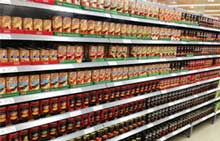
Packaging has also become “politicised”, provoking regulatory and ethical debates: should it be plain and homogeneous, or branded – as in tobacco and cigarette packaging? Should it be paper or plastic for shopping bags in view of the waste management agenda? Should materials be biobased or petroleum-based for packaging, in the interest of curbing marine litter?
Throughout those varying stages, what remains constant is that packaging is both a protective container and a visual communicator. The latter enables added valuation to the product and product differentiation that aid consumers to pick their preferences amid an array of – and at times overwhelming – branding stimuli.
Trend drivers according to studies
In stores, the torrent of packaging colours, labels, nutrition information, and shapes compete for attention of consumers who would usually shortlist preferences by cost or personal bias.
Today’s packaging industry allocates more funding for R&D to get ahead in this shelf space competition.
Transparency Markets Research (TMR), in its Consumer Packaging Market: Global Analysis 2024 report, reiterates how packaging for the consumer goods industry can help the product look aesthetically appealing for the potential buyer, at the same time, deliver products to the consumer in a “sufficiently sophisticated, safe, convenient, and appropriate manner”. Thus, the consumer packaging market has witnessed a significant rise in R&D efforts to develop innovative packaging materials and product designs.
Catering to a new breed of consumers has also seen shifts in the market. According to the Ernst & Young (EY) report, Unwrapping the Packaging Industry, current demographic changes such as the decline of the nuclear family, increase in the average age, in addition to growing market share competition among consumer goods producers, is prompting innovation in packaging. This can be gleaned from new packaging designs showcased in the recent years, based on features enumerated in the EY report: convenience; smaller pack sizes; eye-catching and colourful designs to enhance brand awareness; promotional packs and brand extensions to maintain customer loyalty and for positioning in the mass luxury category of cosmetics and other consumer goods.
The delivery of new shapes, new materials, more colours, and economical short-runs is passed on to the packaging producers, who have to invest in the right technologies and capabilities to be competitive, EY said, adding that ultimately, the end-market users are the real drivers of innovation.
For a busy lifestyle, convenience is a virtue
The fast paced lifestyle has changed how we carry out our activities, as we move double-time, multitask, or juggle with life-work balance. This shift has become a catalyst for the retail industry to deliver their products in the most convenient method.
Now, most products intended for quick consumption, like food, drinks and medicines, come in convenient packaging with easy-open, carry and storage, and resealable features. The increasing demand for on-the-go packaging is bolstering the market, forecast to grow at a CAGR of almost 4.7% from 2016-2020, according to Technavio, in its Global On-the-Go Packaging Market outlook.
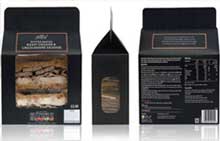
Newer food packaging features like zippers, tear notches, peel-off lids, hand-holes, and microwavability also contribute to this market’s growth over the forecast period, Technavio adds. Building into a growing convenient packaging segment, UK-based flexible packaging manufacturer Coveris has launched Grab Box, a hybrid spin-off to the traditional grab bag concept.
Grab Box is made from board lined with highclarity, low-gauge PP film incorporating antifog properties and features three windows for enhanced product visibility. The format provides an extensive printable area on plain board, on one or both sides, with a combined total of nine colours, allowing additional communication or branding to appear on the inside of the box.
Grab Box is supplied as a flat, pop-up box, quick to erect and simple to hand-fill before being heat sealed, resulting in faster processing speeds, says Coveris. It was launched by British multinational grocery store Tesco last year for its food-to-go sandwiches. The firm says the board (for the Grab Box) comes from sustainable forests.
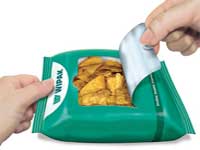
Meanwhile, Wipak UK has developed a range of bags for dry foods that each feature easy laser-scored openings, thereby significantly increasing pack functionality, in a range of formats, including a Stabilo bag, pillow bag and a quad pack pouch, according to Wipak.
The user-friendly packaging can be reclosed using an adhesive label and, as the contents do not need to be decanted into a separate container, the packs can maintain brand identity throughout a product’s lifecycle, conferred Wipak.
The laser technology enables to create the opening of the three pack formats, selectively weakening a specific layer of the film, at the same time ensuring that no barrier characteristics are lost in the process.
Ready to serve meals for time-starved consumers
New York-based research firm, NPD, reports that
the late 1990’s coined-term “grocerant” can aptly
describe current food consumption and food
shopping trends, especially among food patrons who want quick-to-fix, full meals that are
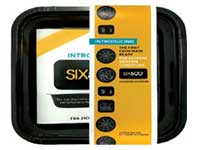 ready-to-eat or heat-and-serve and are usually
availed from supermarkets and groceries.
NPD’s US data shows that in-store dining and
take-out of prepared foods from grocers rose
nearly 30% since 2008; and was poised to reach
almost US$29 billion in 2016.
ready-to-eat or heat-and-serve and are usually
availed from supermarkets and groceries.
NPD’s US data shows that in-store dining and
take-out of prepared foods from grocers rose
nearly 30% since 2008; and was poised to reach
almost US$29 billion in 2016.
The practicality of preparing meals at
a fraction of the time spent for traditional
home-cooking is captured in new packaging
innovation from Havi Global Solutions (HGS).
The US company partnered with Manitowoc
Foodservice (MFS) to offer SIX500, a readyto-
serve accelerated cooking packaging. The
US FDA-compliant SIX500 provides food
processors, convenience stores, and restaurant
operators with an enhanced packaging solution
that can safely withstand temperatures up to
525°F for six minutes. In short, this packaging,
with its use of proprietary moisture barriers
and laminations, is suitable for extreme
commercial oven environments. In addition,
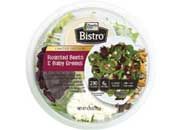 food can be pre-packaged, cooked, and then
served in
the same
packaging
carrier, which
creates time
and labour
efficiencies
throughout
the product
lifecycle.
food can be pre-packaged, cooked, and then
served in
the same
packaging
carrier, which
creates time
and labour
efficiencies
throughout
the product
lifecycle.
Meanwhile, single-serve, portion-sized packaging is gaining a significant on-shelf share, owing to its capability to prevent food wastage while ensuring fresh eating experience.
Californian fresh food retailer, Ready Pac Foods, which was recently acquired by Bonduelle, a French company producing processed vegetables, has launched its latest seasonal creation, the Roasted Beets & Baby Greens Bistro Bowl single-serve salad, an addition to its limited edition roster of singleserve salads it first introduced in 2016. With its convenient packaging, the Bistro Bowl is able to offer a melange of season-fresh ingredients to fresh food consumers.
Food’s “close” encounter of the resealable kind
Since the introduction of zipper storage bags to hold pencils in 1954; and the first branded reusable zipper food bag, Ziploc debuting in 1968, resealable packaging has been adopted to keep food fresh longer, contaminant and spillproof.
Nowadays, more resealing systems are devised for pouches, bags, and other novel packaging. Sales in this segment is projected to clinch more than US$16 billion by 2022, according to Zion Market Research in its Global Resealable Closures and Spouts Packaging Market report, driven by rising application in personal care, food and beverage, cosmetics, healthcare, home care, and other products.
Packaging with closures and spouts are suitable to store condiments, liquid adhesives, creams, and other products. Of the materials used for this segment, plastic is widely preferred due to its light weight and sustainability properties, the research group reported.
US-headquartered Bemis, a major player in
resealables and closures, mentioned by Zion in the report, launched last year its newest offer,
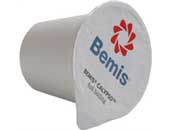 the Calypso foil lidding that peels easily in a
single piece. The no-tear, no-shred solution
has more than two times the tear strength of
traditional foil lidding, Bemis cited.
the Calypso foil lidding that peels easily in a
single piece. The no-tear, no-shred solution
has more than two times the tear strength of
traditional foil lidding, Bemis cited.
Calypso lidding helps to prevent punctures, boasting more than 50% greater puncture strength compared to traditional foil lidding, says Bemis. By keeping products safe, damage and waste are reduced. It is also softer and safer, with edges that won’t cut, reducing consumer complaints and improving the safety of manufacturing workers.
Using significantly less foil than a traditional die-cut lid, this multi-layer structure is said to improve sustainability including lowering CO2 by 35% and energy by 10%, according to Bemis. Calypso can replace heavy gauge foil lidding used in yogurt and additional cultured dairy products, as well as other food, non-food and medical products. Its universal structure can adhere to most cupstock, run on existing equipment and maintain line speeds, Bemis said.
Food safety is also ensured with Klöckner Pentaplast’s APET++ mono PET-based technology for food products. It is said to offer improved sealing properties even with contaminated sealing surfaces, as well as sealing at lower temperatures that will reduce utility costs. Thus, it meets the growing demand for highly secure packaged goods with sustainable materials, said Klöckner Pentaplast, a rigid packaging manufacturer with its main facility in Germany.
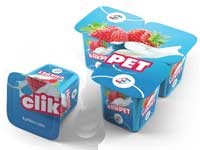
Last November, the company also introduced a PET-based film for yogurt. The Pentafood clikPET, an addition to its Pentafood film line, embodies full PS functionality, complemented by gas and water vapour barrier properties and the ability to bend and click.
Due to the base of PET technology, clikPET products offer safe and sustainable solutions in the marketplace while also reducing complexity, risk and price volatility in the supply chain, explained Klöckner Pentaplast. This packaging technology can extend the shelf life of yogurt products up to ten days, thus enhancing consumers’ needs. Furthermore, Pentafood clikPET’s material properties reduce cup breakage rates to significantly lower levels. It can be used on major FFS lines, seals, labels and trays.
Now for soup and pasta buffs, UK-based Aegg is dishing out its latest range of plastic fresh soup and pasta sauce pots, which feature resealing lid design, have a built-in pouring spout and a lid with a tear back feature, allowing the consumer to microwave safely, helping to prevent spillage of boiling hot soup on a consumer’s hand, Aegg said.
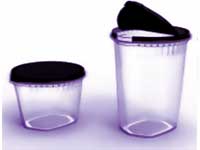
The pots can also be resealed if partly used. In addition, Aegg has designed the pots so that any of three label solutions (adhesive label, in-mould label and print) can be used. There are currently two pot sizes within the range, which are ideal for either a single or double serving, each with the same size diameter at the top, but with 30% less capacity for the smaller pot.
In brief, the emergence of new packaging designs and innovations, which enable packaging to perform better in securing and protecting contents up to the time of consumption, help consumers make that purchase decision with confidence.
(PRA)Copyright (c) 2017 www.plasticsandrubberasia.com. All rights reserved.



















































